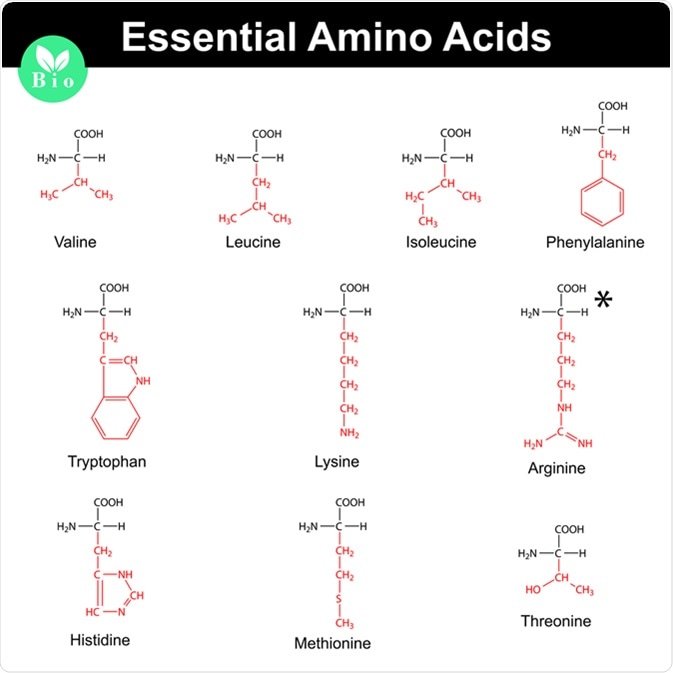Amino acids are the monomeric compounds that combine to form proteins. Essential amino acids cannot be made by the body, so must come from our diet.
Synthesis of Essential Amino Acids
The essential amino acids are not synthesized in humans but are synthesized in either plants or bacteria. The 9 essential amino acids are histidine (His), isoleucine (Ile), leucine (Leu), methionine (Met), phenylalanine (Phe), threonine (Thr), tryptophan (Trp), and valine (Val). Phe and Trp are aromatic amino acids. The synthesis of these two amino acids begins with the conversion of phosphoenolpyruvate and erythrose-4-phosphate into chorismate via the shikimate pathway.
Chorismate is subsequently converted into Phe via the aromatic amino acid biosynthesis pathway. For the synthesis of Trp, chorismate is converted into Anthranilate by anthranilate synthase. Through the actions of 4 enzymes, Anthranilate is converted into Trp.
The synthesis of His occurs in plants. Ribose-5-phosphate is converted into Histidinol through the actions of 9 enzymes. Histidinol is then converted into L-Histidine which is catalyzed by a histidinol dehydrogenase.
Thr, Met, and Ile are all synthesized through the Aspartate (Asp) family pathway. Asp is converted into aspartyl phosphate and then aspartyl semialdehyde. Aspartyl semialdehyde is subsequently converted into O-phosphohomoserine. O-phosphohomoserine is converted into Thr by Thr synthase, it is also converted into Met through the actions of 3 enzymes including Met synthase.
Both Met and Thr can be converted into 2-Oxobutanoate by Met γ-synthase and Thr dehydrogenase, respectively. 2-Oxobutanoate is then converted into Ile through the actions of 4 enzymes. Ile can also be synthesized from Thr in a different pathway through the actions of 5 enzymes.
Leu and Val are synthesized from pyruvate in plants. Pyruvate is converted into 3-Methyl-2-methyl butanoate through the actions of 3 enzymes. 3-Methyl-2-methyl butanoate can be converted into Val by branched-chain aminotransferase (BCAT), and it can also be converted into Leu through the actions of 3 enzymes including BCAT.

Main essential amino acids with marked radicals, chemical structural formulas. Image Credit: Chromatos / Shutterstock
Metabolism of the Essential Amino Acids
The essential amino acids are involved in many pathways and processes that are crucial for the homeostasis of the body. Met is needed for the synthesis of Cysteine (Cys). Condensation of ATP and Met is catalyzed by Met adenosyltransferase (MAT), which creates S-adenosylmethionine (SAM). SAM can then be converted into Cys through the actions of 3 enzymes. SAM is also used by DNA methyltransferases in the methylation of cytidine residues found in CpG dinucleotides in DNA, which regulates gene expression.
Phe is synthesized into Tyr which is catalyzed by phenylalanine hydroxylase. Phe can also be incorporated into polypeptide chains. Thr is catabolized in the mitochondria in mammals, which is catalyzed by threonine dehydrogenase (TDH) producing α-amino-β-ketobutyrate. The α-amino-β-ketobutyrate can either be converted into acetyl-CoA and glycine via the actions of α-amino-β-ketobutyrate coenzyme A ligase, or it can degrade into aminoacetone which will be converted into pyruvate.
Leu, Ile, and Val are all branched-chain amino acids (BCAA). The catabolism of these amino acids is the highest in skeletal muscle but also occurs in most cells within the body. BCAA catabolism also produces NADH and FADH2 which are utilized for ATP generation. This is a reason for the high rates of BCAA catabolism in skeletal muscle.
The first few steps for the BCAA catabolism involves transamination using a branched-chain aminotransferase (BCAT) with 2-oxoglutarate as the amino acceptor. Using the BCAT reaction, the three BCCAs are converted into three different α-keto acids, which are oxidized using a branched-chain α-keto acid dehydrogenase (BCKD) complex. This produces three different CoA derivatives, each of which can be converted into more useful compounds. BCKD activity is inhibited by phosphorylated and activated by dephosphorylation. During this pathway Ile eventually becomes acetyl-CoA and propionyl-CoA, Leu eventually becomes acetyl-CoA and acetoacetate, and Val eventually becomes propionyl-CoA.
In conclusion, the essential amino acids are very important for many metabolic processes within the body. They are needed to produce other non-essential amino acids, and they are also involved in processes such a gene regulation and ATP generation. It is very clear that the synthesis and metabolism of the essential amino acids are very complex, so more research in this area will provide a better understanding of these processes.